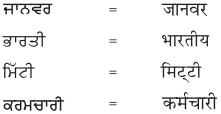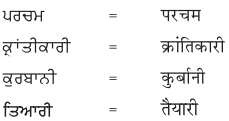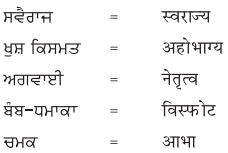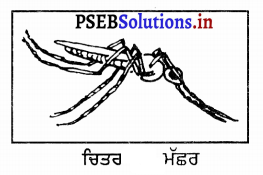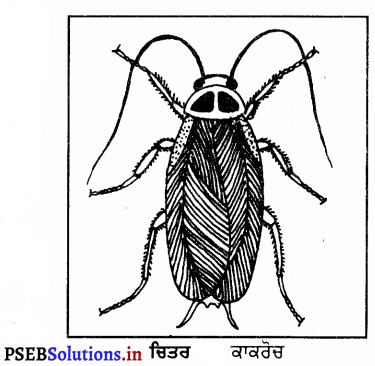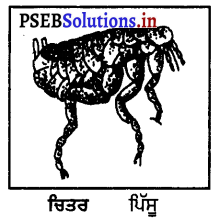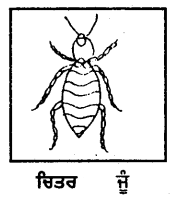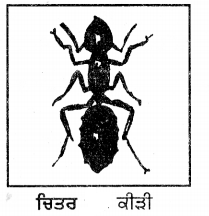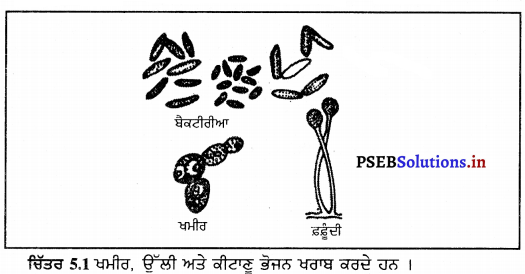Punjab State Board PSEB 8th Class Home Science Book Solutions Chapter 6 ਕਾਰਜਾਤਮਕ ਫ਼ਰਨੀਚਰ Textbook Exercise Questions and Answers.
PSEB Solutions for Class 8 Home Science Chapter 6 ਕਾਰਜਾਤਮਕ ਫ਼ਰਨੀਚਰ
Home Science Guide for Class 8 PSEB ਕਾਰਜਾਤਮਕ ਫ਼ਰਨੀਚਰ Textbook Questions and Answers
ਅਭਿਆਸ ਦੇ ਪ੍ਰਸ਼ਨਾਂ ਦੇ ਉੱਤਰ
ਵਸਤੂਨਿਸ਼ਠ ਪ੍ਰਸ਼ਨ
ਪ੍ਰਸ਼ਨ 1.
ਕਾਰਜਾਤਮਕ ਫ਼ਰਨੀਚਰ ਤੋਂ ਕੀ ਭਾਵ ਹੈ ?
ਉੱਤਰ-
ਜੋ ਫ਼ਰਨੀਚਰ ਕਿਸੇ ਖ਼ਾਸ ਕੰਮ ਲਈ ਇਸਤੇਮਾਲ ਕੀਤਾ ਜਾਂਦਾ ਹੋਵੇ ।
ਪ੍ਰਸ਼ਨ 2.
ਕੰਮ ਦੇ ਪੱਖੋਂ ਫ਼ਰਨੀਚਰ ਕਿੰਨੀ ਤਰਾਂ ਦਾ ਹੁੰਦਾ ਹੈ ?
ਉੱਤਰ-
ਦੋ ਤਰ੍ਹਾਂ ਦਾ-
- ਕਾਰਜਾਤਮਕ
- ਕੇਵਲ ਸਜਾਵਟੀ ।
ਪ੍ਰਸ਼ਨ 3.
ਮੇਜ਼ ਦੇ ਉੱਪਰਲੇ ਪਾਸੇ ਸਨਮਾਇਕਾ ਲਗਾਉਣ ਦਾ ਕੀ ਲਾਭ ਹੈ ?
ਉੱਤਰ-
ਮੇਜ਼ ਦੇ ਉੱਪਰਲੇ ਪਾਸੇ ਤੇ ਸਨਮਾਈਕਾ ਲਾਉਣ ਨਾਲ ਮੇਜ਼ ਸਾਫ਼ ਕਰਨਾ ਸੌਖਾ ਰਹਿੰਦਾ ਹੈ ।

ਪ੍ਰਸ਼ਨ 4.
ਫ਼ਰਨੀਚਰ ਕਿਸ ਕਿਸਮ ਦੀ ਲੱਕੜੀ ਦਾ ਹੋ ਸਕਦਾ ਹੈ ?
ਉੱਤਰ-
ਫ਼ਰਨੀਚਰ ਮਜ਼ਬੂਤ ਅਤੇ ਚੰਗੀ ਤਰ੍ਹਾਂ ਪੱਕੀ ਹੋਈ ਲੱਕੜੀ ਦਾ ਹੋ ਸਕਦਾ ਹੈ ।
ਪ੍ਰਸ਼ਨ 5.
ਕਿਹੜੀ ਕਿਸਮ ਦੀ ਲੱਕੜੀ ਫ਼ਰਨੀਚਰ ਲਈ ਸਭ ਤੋਂ ਚੰਗੀ ਰਹਿੰਦੀ ਹੈ ?
मां
ਫ਼ਰਨੀਚਰ ਬਣਾਉਣ ਵਿਚ ਆਮ ਤੌਰ ‘ਤੇ ਕਿਹੜੀ-ਕਿਹੜੀ ਲੱਕੜੀ ਦਾ ਪ੍ਰਯੋਗ ਕੀਤਾ ਜਾਂਦਾ ਹੈ ?
ਉੱਤਰ-
ਟੀਕ, ਮਹੋਗਨੀ, ਗੁਲਾਬ ਅਤੇ ਅਖਰੋਟ ਦੀ ਲੱਕੜੀ ਫ਼ਰਨੀਚਰ ਦੇ ਲਈ ਸਭ ਤੋਂ ਚੰਗੀ ਰਹਿੰਦੀ ਹੈ ।
ਪ੍ਰਸ਼ਨ 6.
ਪਲੰਘ ਦਾ ਆਮ ਮਾਪ ਕੀ ਹੁੰਦਾ ਹੈ ਅਤੇ ਬੱਚਿਆਂ ਲਈ ਕਿਹੋ ਜਿਹਾ ਮੰਜਾ ਹੋ ਸਕਦਾ ਹੈ ?
ਉੱਤਰ-
ਪਲੰਘ ਦਾ ਆਮ ਮਾਪ 21/2 ਤੋਂ 31/2 ਫੁੱਟ ਤਕ ਚੌੜਾ ਅਤੇ 61/2 ਫੁੱਟ ਤਕ ਲੰਮਾ ਹੁੰਦਾ . ਹੈ । ਬੱਚਿਆਂ ਦੇ ਲਈ ਛੋਟਾ ਮੰਜਾ ਹੋ ਸਕਦਾ ਹੈ । ਇਸ ਦਾ ਮਾਪ 4′ × 2’ ਹੁੰਦਾ ਹੈ ।
ਪ੍ਰਸ਼ਨ 7.
ਪੜ੍ਹਾਈ ਵਾਲੀ ਮੇਜ਼ ਦਾ ਆਮ ਮਾਪ ਕੀ ਹੋ ਸਕਦਾ ਹੈ ?
ਉੱਤਰ-
ਪੜਾਈ ਵਾਲੀ ਮੇਜ਼ ਦਾ ਆਮ ਮਾਪ 21/2 ਫੁੱਟ × 4 ਫੁੱਟ ਅਤੇ ਉਚਾਈ 2 ਫੁੱਟ ਹੋ ਸਕਦੀ ਹੈ ।
ਪ੍ਰਸ਼ਨ 8.
ਪੜ੍ਹਾਈ ਵਾਲੀ ਮੇਜ਼ ਤੇ ਕੰਮ ਕਰਦੇ ਸਮੇਂ ਕਿਹੋ ਜਿਹੀ ਕੁਰਸੀ ਦਾ ਇਸਤੇਮਾਲ ਕਰਨਾ ਚਾਹੀਦਾ ਹੈ ?
ਉੱਤਰ-
ਪੜ੍ਹਾਈ ਵਾਲੀ ਮੇਜ਼ ਉੱਤੇ ਕੰਮ ਕਰਦੇ ਸਮੇਂ ਕੁਰਸੀ ਸਿੱਧੀ ਪਿੱਠ ਵਾਲੀ ਅਤੇ ਬਾਹਾਂ ਵਾਲੀ ਇਸਤੇਮਾਲ ਕਰਨੀ ਚਾਹੀਦੀ ਹੈ ।

ਛੋਟੇ ਉੱਤਰਾਂ ਵਾਲੇ ਪ੍ਰਸ਼ਨ
ਪ੍ਰਸ਼ਨ 9.
ਭਾਰਤੀ ਮੌਸਮ ਅਨੁਸਾਰ ਕਿਸ ਤਰ੍ਹਾਂ ਦਾ ਫ਼ਰਨੀਚਰ ਹੋਣਾ ਜ਼ਰੂਰੀ ਹੈ ?
ਉੱਤਰ-
ਭਾਰਤੀ ਮੌਸਮ ਅਨੁਸਾਰ ਹੇਠ ਲਿਖੇ ਤਰ੍ਹਾਂ ਦਾ ਫ਼ਰਨੀਚਰ ਹੋਣਾ ਚਾਹੀਦਾ ਹੈ
- ਫ਼ਰਨੀਚਰ ਨਵੇਂ ਡਿਜ਼ਾਈਨ ਦਾ ਹੋਵੇ ।
- ਫ਼ਰਨੀਚਰ ਕਮਰੇ ਦੇ ਆਕਾਰ ਦਾ ਹੋਵੇ ।
- ਫ਼ਰਨੀਚਰ ਆਰਥਿਕ ਪੱਖੋਂ ਫਜੂਲਖ਼ਰਚੀ ਨਾ ਹੋਵੇ |
- ਫ਼ਰਨੀਚਰ ਕਮਰੇ ਦੇ ਲਈ ਉਪਯੋਗੀ ਹੋਵੇ ।
- ਫ਼ਰਨੀਚਰ ਮਜ਼ਬੂਤ ਤੇ ਟਿਕਾਉ ਹੋਵੇ ।
- ਫ਼ਰਨੀਚਰ ਉਪਯੋਗੀ ਅਤੇ ਸੁੰਦਰ ਹੋਣ ਦੇ ਨਾਲ-ਨਾਲ ਆਰਾਮਦੇਹ ਹੋਵੇ ।
- ਫ਼ਰਨੀਚਰ ਉਠਾਉਣ-ਧਰਨ ਵਿਚ ਸੁਵਿਧਾਜਨਕ ਹੋਵੇ ।
- ਫ਼ਰਨੀਚਰ ਹਮੇਸ਼ਾ ਚੰਗੇ ਕਾਰੀਗਰ ਦੁਆਰਾ ਬਣਿਆ ਹੋਵੇ ।
ਪ੍ਰਸ਼ਨ 10.
ਬੈਠਣ ਵਾਲੇ ਅਤੇ ਖਾਣ ਵਾਲੇ ਕਮਰਿਆਂ ਵਿਚ ਕਿਹੜਾ-ਕਿਹੜਾ ਫ਼ਰਨੀਚਰ ਜ਼ਰੂਰੀ ਹੈ ?
ਉੱਤਰ-
ਬੈਠਣ ਵਾਲੇ ਕਮਰਿਆਂ ਵਿਚ ਫ਼ਰਨੀਚਰ – ਸੋਫਾਸੈਟ, ਗੱਦੇਦਾਰ ਕੁਰਸੀਆਂ, ਮੇਜ਼, ਕਾਫੀ ਟੇਬਲ, ਸੈਂਟਰ ਟੇਬਲ ਅਤੇ ਆਰਾਮ ਕੁਰਸੀਆਂ ।
ਖਾਣ ਵਾਲੇ ਕਮਰੇ ਵਿਚ ਫ਼ਰਨੀਚਰ – ਭੋਜਨ ਦੀ ਮੇਜ਼, ਕੁਰਸੀਆਂ, ਪਰੋਸਣ ਦੀ ਮੇਜ਼, ਸਾਈਡਬੋਰਡ ਟਰਾਲੀ (ਪਹੀਏ ਵਾਲੀ ਮੇਜ਼) ।
ਪ੍ਰਸ਼ਨ 11.
ਪੜਾਈ ਵਾਲੇ ਕਮਰੇ ਦੀ ਜ਼ਰੂਰਤ ਕਿਉਂ ਸਮਝੀ ਜਾਂਦੀ ਹੈ ? ਇਸ ਵਿਚ ਕਿਸ ਤਰਾਂ ਦਾ ਫ਼ਰਨੀਚਰ ਹੋਣਾ ਚਾਹੀਦਾ ਹੈ ?
ਉੱਤਰ-
ਸਿੱਖਿਆ ਦੇ ਪ੍ਰਸਾਰ ਨਾਲ ਸਾਡੇ ਦੇਸ਼ ਵਿਚ ਵੀ ਪੱਛਮੀ ਦੇਸ਼ਾਂ ਦੀ ਤਰ੍ਹਾਂ ਪੜ੍ਹਾਈ ਵਾਲੇ ਕਮਰੇ ਦੀ ਲੋੜ ਹੈ ਜਿਸ ਵਿਚ ਬੱਚਿਆਂ ਦੀ ਪੜ੍ਹਾਈ ਸਹੀ ਢੰਗ ਨਾਲ ਹੋ ਸਕੇ ।
ਪੜ੍ਹਨ ਵਾਲੇ ਕਮਰੇ ਦਾ ਫ਼ਰਨੀਚਰ – ਪੜ੍ਹਨ ਵਾਲਾ ਮੇਜ਼, ਕੁਰਸੀ, ਕਿਤਾਬਾਂ ਦੀ ਅਲਮਾਰੀ ਆਦਿ ਹੋਣੇ ਚਾਹੀਦੇ ਹਨ | ਮੇਜ਼ ਦਾ ਆਮ ਮਾਪ 2 ਫੁੱਟ × 4 ਫੁੱਟ ਅਤੇ 21/2 ਫੁੱਟ ਉਚਾਈ ਹੁੰਦੀ ਹੈ । ਪਰ ਮੇਜ਼ ਇਸ ਤੋਂ ਲੰਬਾ ਅਤੇ ਚੌੜਾ ਵੀ ਹੋ ਸਕਦਾ ਹੈ । ਮੇਜ਼ ਇੰਨਾ ਹੋਣਾ ਚਾਹੀਦਾ ਹੈ ਕਿ ਇਸ ਉੱਤੇ ਇਕ ਲੈਂਪ, ਕਿਤਾਬਾਂ, ਸ਼ਬਦ ਕੋਸ਼ (ਡਿਕਸ਼ਨਰੀ, ਪੈੱਨ, ਪੈਨਸਿਲਾਂ ਆਦਿ ਅਸਾਨੀ ਨਾਲ ਆ ਸਕਣ। ਜੇ ਟਾਈਪਰਾਈਟਰ ਰੱਖਣ ਦੀ ਥਾਂ ਹੋ ਸਕੇ ਤਾਂ ਹੋਰ ਵੀ ਚੰਗਾ ਹੈ ।
ਕੁਰਸੀ ਸਿੱਧੀ ਪਿੱਠ ਵਾਲੀ ਅਤੇ ਬਾਹਵਾਂ ਵਾਲੀ ਹੋਣੀ ਚਾਹੀਦੀ ਹੈ । ਇਸ ਦੀ ਸੀਟ ਬੈਂਤ ਦੀ ਜਾਂ ਗੱਦੇਦਾਰ ਹੋ ਸਕਦੀ ਹੈ । ਜੇਕਰ ਟਾਈਪ ਦਾ ਇੰਤਜ਼ਾਮ ਹੋਵੇ ਤਾਂ ਇਹ ਕੁਰਸੀ ਪਹੀਆਂ ਵਾਲੀ ਹੋਣੀ ਚਾਹੀਦੀ ਹੈ ਤਾਂ ਕਿ ਜ਼ਰੂਰਤ ਪੈਣ ‘ਤੇ ਇਸ ਨੂੰ ਟਾਈਪਰਾਈਟਰ ਵੱਲ ਜਾਂ ਮੇਜ਼ ਵੱਲ ਘੁਮਾਇਆ ਜਾ ਸਕੇ ।
ਕਿਤਾਬਾਂ ਲਈ ਸ਼ੈਲਫ਼ਾਂ ਵਾਲੀ ਅਲਮਾਰੀ ਇਸ ਕਮਰੇ ਵਿਚ ਹੋਣੀ ਚਾਹੀਦੀ ਹੈ | ਸਾਡੇ ਦੇਸ਼ ਦੇ ਮੌਸਮ ਅਨੁਸਾਰ ਸ਼ੀਸ਼ਿਆਂ ਵਾਲੀ ਅਲਮਾਰੀ ਹੋਵੇ ਤਾਂ ਵਧੇਰੇ ਚੰਗਾ ਰਹੇਗਾ । ਕਿਉਂਕਿ ਮਿੱਟੀ ਘੱਟੇ ਤੋਂ ਕਿਤਾਬਾਂ ਸੁਰੱਖਿਅਤ ਰੱਖੀਆਂ ਜਾ ਸਕਣ ।
ਪ੍ਰਸ਼ਨ 12.
ਲੱਕੜੀ ਦੇ ਫ਼ਰਨੀਚਰ ਦੀ ਕਿਸ ਤਰ੍ਹਾਂ ਦੇਖ-ਭਾਲ ਕਰੋਗੇ ?
ਉੱਤਰ-
ਲੱਕੜੀ ਦੇ ਫ਼ਰਨੀਚਰ ਦੀ ਦੇਖ-ਭਾਲ ਲਈ ਹੇਠ ਲਿਖੀਆਂ ਗੱਲਾਂ ਦਾ ਧਿਆਨ ਰੱਖਣਾ ਚਾਹੀਦਾ ਹੈ-
- ਫ਼ਰਨੀਚਰ ਦੀ ਸਫ਼ਾਈ ਹਰ ਰੋਜ਼ ਕੀਤੀ ਜਾਣੀ ਚਾਹੀਦੀ ਹੈ ।
- ਫ਼ਰਨੀਚਰ ਨੂੰ ਬੜੀ ਸਾਵਧਾਨੀ ਨਾਲ ਇਕ ਥਾਂ ਤੋਂ ਦੂਜੀ ਥਾਂ ਤਕ ਲੈ ਜਾਣਾ ਚਾਹੀਦਾ ਹੈ ।
- ਫ਼ਰਨੀਚਰ ਨੂੰ ਖਿੱਚਣਾ ਜਾਂ ਘਸੀਟਣਾ ਨਹੀਂ ਚਾਹੀਦਾ । ਫ਼ਰਨੀਚਰ ਨੂੰ ਰਗੜ ਲੱਗਣ ਤੋਂ ਵੀ ਬਚਾਉਣਾ ਚਾਹੀਦਾ ਹੈ ।
- ਫ਼ਰਨੀਚਰ ਤੇ ਕਿਸੇ ਪ੍ਰਕਾਰ ਦੀ ਖਾਣ ਵਾਲੀ ਚੀਜ਼ ਨਾ ਡਿੱਗੇ, ਜੇਕਰ ਡਿਗ ਜਾਏ ਤਾਂ ਉਸ ਨੂੰ ਉਸੇ ਵੇਲੇ ਸਾਫ਼ ਕਰ ਦੇਣਾ ਚਾਹੀਦਾ ਹੈ ਨਹੀਂ ਤਾਂ ਦਾਗ ਧੱਬੇ ਪੈਣ ਦਾ ਡਰ ਰਹਿੰਦਾ ਹੈ ।
ਪ੍ਰਸ਼ਨ 13.
ਗੱਦੇਦਾਰ ਅਤੇ ਚਮੜੇ ਦੇ ਫ਼ਰਨੀਚਰ ਨੂੰ ਕਿਸ ਤਰ੍ਹਾਂ ਸਾਫ਼ ਕਰੋਗੇ ?
ਉੱਤਰ-
ਗੱਦੇਦਾਰ ਅਤੇ ਚਮੜੇ ਦੇ ਫ਼ਰਨੀਚਰ ਨੂੰ ਹੇਠ ਲਿਖੇ ਤਰੀਕੇ ਨਾਲ ਸਾਫ਼ ਰੱਖਣਾ ਚਾਹੀਦਾ ਹੈ-
- ਹਰ ਰੋਜ਼ ਸਾਫ਼ ਕੱਪੜੇ ਨਾਲ ਝਾੜਨਾ ਚਾਹੀਦਾ ਹੈ ।
- ਕਦੀ-ਕਦੀ ਕੋਸੇ ਪਾਣੀ ਵਿਚ ਨਰਮ ਸਾਬਣ ਦਾ ਘੋਲ ਬਣਾ ਕੇ, ਕੱਪੜੇ ਨਾਲ ਇਹ ਘੋਲ ਲਗਾ ਕੇ ਰੈਕਸੀਨ ਨੂੰ ਸਾਫ਼ ਕਰਨਾ ਚਾਹੀਦਾ ਹੈ ।
- ਸਾਫ਼ ਕਰਨ ਤੋਂ ਮਗਰੋਂ ਪਾਲਿਸ਼ ਕਰਨਾ ਚਾਹੀਦਾ ਹੈ ਤਾਂ ਕਿ ਚਮੜਾ ਨਰਮ ਹੋ ਜਾਏ ਅਤੇ ਫਟੇ ਨਹੀਂ ।
ਪ੍ਰਸ਼ਨ 14.
ਬੈਂਤ ਦੇ ਫ਼ਰਨੀਚਰ ਦਾ ਕੀ ਲਾਭ ਹੈ ਅਤੇ ਇਸ ਨੂੰ ਕਿਸ ਤਰ੍ਹਾਂ ਸਾਫ਼ ਕਰੋਗੇ ?
ਉੱਤਰ-
ਬੈਂਤ ਦੇ ਫ਼ਰਨੀਚਰ ਤੋਂ ਹੇਠ ਲਿਖੇ ਲਾਭ ਹਨ-
- ਬੈਂਤ ਦਾ ਫ਼ਰਨੀਚਰ ਲੱਕੜੀ ਨਾਲੋਂ ਹਲਕਾ ਹੁੰਦਾ ਹੈ ।
- ਇਹ ਲੱਕੜੀ ਦੇ ਫ਼ਰਨੀਚਰ ਨਾਲੋਂ ਸੌਖ ਨਾਲ ਬਾਹਰ ਕੱਢਿਆ ਜਾ ਸਕਦਾ ਹੈ ।
- ਇਹ ਲੱਕੜੀ ਦੇ ਫ਼ਰਨੀਚਰ ਨਾਲੋਂ ਸਸਤਾ ਹੁੰਦਾ ਹੈ ।
ਹਾਨੀਆਂ-
- ਇਸ ਫ਼ਰਨੀਚਰ ਨੂੰ ਕੁੱਤਿਆਂ ਬਿੱਲੀਆਂ ਤੋਂ ਬਚਾਉਣਾ ਪੈਂਦਾ ਹੈ ।
- ਇਹ ਲੰਬੇ ਸਮੇਂ ਤਕ ਚਲਣਯੋਗ ਨਹੀਂ ਹੁੰਦੇ ।
ਬੈਂਤ ਤੇ ਫ਼ਰਨੀਚਰ ਦੀ ਸਫ਼ਾਈ-
- ਬੈਂਤ ਵਾਲੇ ਫ਼ਰਨੀਚਰ ਨੂੰ ਰੋਜ਼ ਕੱਪੜੇ ਜਾਂ ਬੁਰਸ਼ ਨਾਲ ਸਾਫ਼ ਕਰਨਾ ਚਾਹੀਦਾ ਹੈ ।
- ਬੈਂਤ ਵਾਲੇ ਫ਼ਰਨੀਚਰ ਨੂੰ ਨਮਕ ਦੇ ਪਾਣੀ ਨਾਲ ਸਾਫ਼ ਕਰਨਾ ਚਾਹੀਦਾ ਹੈ ।

ਪ੍ਰਸ਼ਨ 15.
ਮੀਨਾਕਾਰੀ ਵਾਲੇ ਫ਼ਰਨੀਚਰ ਦਾ ਕੀ ਲਾਭ ਅਤੇ ਨੁਕਸਾਨ ਹੈ ?
ਉੱਤਰ-
ਲਾਭ-
- ਮੀਨਾਕਾਰੀ ਵਾਲਾ ਫ਼ਰਨੀਚਰ ਵੇਖਣ ਵਿਚ ਸੁੰਦਰ ਲੱਗਦਾ ਹੈ ।
- ਇਸ ਨਾਲ ਕਮਰਾ ਆਕਰਸ਼ਕ ਲਗਦਾ ਹੈ ।
ਹਾਨੀ-
- ਸਾਡੇ ਇੱਥੇ ਤੇਜ਼ ਹਵਾਵਾਂ ਚਲਦੀਆਂ ਹਨ ਜਿਸ ਕਾਰਨ ਮੀਨਾਕਾਰੀ ਵਾਲੇ ਫ਼ਰਨੀਚਰ ‘ਤੇ ਧੂੜ-ਮਿੱਟੀ ਦੀਆਂ ਤਹਿਆਂ ਜੰਮ ਜਾਂਦੀਆਂ ਹਨ ।
- ਇਸ ਫ਼ਰਨੀਚਰ ਦੀ ਸੌਖ ਨਾਲ ਸਹੀ ਸਫ਼ਾਈ ਨਹੀਂ ਹੁੰਦੀ ।
- ਸਫ਼ਾਈ ਨਾ ਹੋਣ ਨਾਲ ਇਹ ਅਣ-ਆਕਰਸ਼ਕ ਵਿਖਾਈ ਦੇਣ ਲੱਗਦਾ ਹੈ ।
ਨਿਬੰਧਾਤਮਕ ਪ੍ਰਸ਼ਨ
ਪ੍ਰਸ਼ਨ 16.
ਫ਼ਰਨੀਚਰ ਦੀ ਚੋਣ ਕਰਦੇ ਸਮੇਂ ਕਿਹੜੀਆਂ ਗੱਲਾਂ ਦਾ ਧਿਆਨ ਰੱਖਣਾ ਜ਼ਰੂਰੀ ਹੈ ?
ਉੱਤਰ-
ਫ਼ਰਨੀਚਰ ਦੀ ਚੋਣ ਕਰਦੇ ਸਮੇਂ ਅੱਗੇ ਲਿਖੀਆਂ ਗੱਲਾਂ ਤੇ ਧਿਆਨ ਦੇਣਾ ਜ਼ਰੂਰੀ ਹੈ-
- ਉਪਯੋਗਤਾ
- ਸੁੰਦਰਤਾ
- ਡਿਜ਼ਾਈਨ
- ਆਰਾਮਦੇਹੀ
- ਮੁੱਲ
- ਮਜ਼ਬੂਤੀ
- ਆਕਾਰ ।
1. ਉਪਯੋਗਤਾ – ਕੇਵਲ ਉਪਯੋਗੀ ਫ਼ਰਨੀਚਰ ਦੀ ਹੀ ਚੋਣ ਕਰਨੀ ਚਾਹੀਦੀ ਹੈ । ਅਣਉਪਯੋਗੀ ਫ਼ਰਨੀਚਰ ਕਿੰਨਾ ਹੀ ਸੁੰਦਰ ਕਿਉਂ ਨਾ ਹੋਵੇ ਉਹ ਸਾਡੇ ਲਈ ਕੋਈ ਮਹੱਤਵ ਨਹੀਂ ਰੱਖਦਾ ।
2. ਸੁੰਦਰਤਾ – ਫ਼ਰਨੀਚਰ ਆਕਰਸ਼ਕ ਤੇ ਸੰਤੋਖਜਨਕ ਹੋਣਾ ਚਾਹੀਦਾ ਹੈ । ਸਾਧਾਰਨ ਨਿਯਮਾਂ ਦਾ ਪਾਲਣ ਕਰਦੇ ਹੋਏ ਸੁੰਦਰਤਾ ਦਾ ਧਿਆਨ ਦੇਣਾ ਚਾਹੀਦਾ ਹੈ ।
3. ਬਨਾਵਟ (ਡਿਜ਼ਾਈਨ – ਮਕਾਨ ਦੀ ਬਨਾਵਟ ਦੇ ਅਨੁਸਾਰ ਫ਼ਰਨੀਚਰ ਆਧੁਨਿਕ, ਸਾਦਾ ਜਾਂ ਪੁਰਾਣੇ ਡਿਜ਼ਾਈਨ ਦਾ ਹੋ ਸਕਦਾ ਹੈ । ਆਧੁਨਿਕ ਮਕਾਨ ਵਿਚ ਪੁਰਾਣੇ ਡਿਜ਼ਾਈਨ ਦਾ ਫ਼ਰਨੀਚਰ ਸ਼ੋਭਾ ਨਹੀਂ ਦਿੰਦਾ | ਆਧੁਨਿਕ ਮਕਾਨ ਦਾ ਸਾਰਾ ਫ਼ਰਨੀਚਰ ਆਧੁਨਿਕ ਹੀ ਹੋਣਾ ਚਾਹੀਦਾ ਹੈ ।
4. ਆਰਾਮਦੇਹ-ਫ਼ਰਨੀਚਰ ਦੀ ਵਿਸ਼ੇਸ਼ਤਾ ਉਸ ਦਾ ਆਰਾਮਦੇਹ ਹੋਣਾ ਹੈ ।ਉੱਠਣ-ਬੈਠਣ ਅਤੇ ਸੌਣ ਵਿਚ ਕਸ਼ਟ ਦੇਣ ਵਾਲਾ ਫ਼ਰਨੀਚਰ ਕਿੰਨਾ ਹੀ ਸੁੰਦਰ ਕਿਉਂ ਨਾ ਹੋਵੇ ਬੇਕਾਰ ਹੁੰਦਾ ਹੈ ।
5. ਮੁੱਲ – ਘਰ ਦੀ ਆਰਥਿਕ ਸਥਿਤੀ ਅਤੇ ਫ਼ਰਨੀਚਰ ਦੇ ਮੁੱਲ ਵਿਚ ਤਾਲਮੇਲ ਹੋਣਾ ਚਾਹੀਦਾ ਹੈ । ਆਪਣੀ ਆਰਥਿਕ ਸਥਿਤੀ ਤੋਂ ਬਾਹਰ ਨਿਕਲ ਕੇ ਖ਼ਰਚ ਕਰਨਾ ਬੁੱਧੀਮਾਨੀ ਨਹੀਂ ਹੈ । ਬਹੁਤ ਸਸਤਾ ਫ਼ਰਨੀਚਰ ਨਹੀਂ ਖ਼ਰੀਦਣਾ ਚਾਹੀਦਾ ਕਿਉਂਕਿ ਉਹ ਟਿਕਾਊ ਨਹੀਂ ਹੋ ਸਕਦਾ ।
6. ਮਜ਼ਬੂਤੀ – ਫ਼ਰਨੀਚਰ ਸੁੰਦਰ ਹੋਣ ਦੇ ਨਾਲ-ਨਾਲ ਮਜ਼ਬੂਤ ਵੀ ਹੋਣਾ ਚਾਹੀਦਾ ਹੈ । ਚੀਲ ਦੀ ਲੱਕੜੀ ਦੇ ਫ਼ਰਨੀਚਰ ਛੇਤੀ ਟੁੱਟ ਜਾਂਦੇ ਹਨ । ਸਾਗਵਾਨ ਤੇ ਟਾਹਲੀ ਦੀ ਲੱਕੜੀ ਦੇ ਫ਼ਰਨੀਚਰ ਮਜ਼ਬੂਤ ਹੁੰਦੇ ਹਨ | ਸਟੀਲ ਜਾਂ ਲੋਹੇ ਦੇ ਫ਼ਰਨੀਚਰ ਵਿਚ ਚਾਦਰ ਦੀ ਮਜ਼ਬੂਤੀ ਦਾ ਧਿਆਨ ਰੱਖਣਾ ਚਾਹੀਦਾ ਹੈ ।
7. ਆਕਾਰ – ਫ਼ਰਨੀਚਰ ਦੀ ਚੋਣ ਕਮਰੇ ਦੇ ਆਕਾਰ ਦੇ ਆਧਾਰ ‘ਤੇ ਹੀ ਕਰਨੀ ਚਾਹੀਦੀ ਹੈ । ਛੋਟੇ ਕਮਰਿਆਂ ਵਿਚ ਛੋਟੇ ਆਕਾਰ ਦਾ ਫ਼ਰਨੀਚਰ ਅਤੇ ਵੱਡੇ ਕਮਰਿਆਂ ਵਿਚ ਵੱਡੇ ਆਕਾਰ ਦਾ ਫ਼ਰਨੀਚਰ ਹੀ ਠੀਕ ਰਹਿੰਦਾ ਹੈ ।
ਪ੍ਰਸ਼ਨ 17.
ਫ਼ਰਨੀਚਰ ਉੱਤੇ ਲੱਗੇ ਘਿਓ, ਤੇਲ, ਪੇਂਟ ਅਤੇ ਲੁਕ ਆਦਿ ਦੇ ਦਾਗ ਕਿਵੇਂ ਉਤਾਰੇ ਜਾ ਸਕਦੇ ਹਨ ?
ਉੱਤਰ-
- ਤਰਲ ਪਦਾਰਥਾਂ ਨੂੰ ਕਿਸੇ ਸਾਫ਼ ਕੱਪੜੇ ਨਾਲ ਪੂੰਝ ਦੇਣਾ ਚਾਹੀਦਾ ਹੈ ।
- ਚੀਕਣੇ ਅਤੇ ਚਿਪਕਣ ਵਾਲੇ ਦਾਗਾਂ ਦੇ ਲਈ ਕੋਸੇ ਪਾਣੀ ਦੀ ਵਰਤੋਂ ਕਰਨੀ ਚਾਹੀਦੀ ਹੈ । ਲੋੜ ਹੋਵੇ ਤਾਂ ਕਿਸੇ ਨਰਮ ਸਾਬਣ ਦੀ ਵਰਤੋਂ ਕਰਨੀ ਚਾਹੀਦੀ ਹੈ । ਲੱਕੜੀ ਨੂੰ ਜ਼ਿਆਦਾ ਗਿੱਲਾ ਨਹੀਂ ਕਰਨਾ ਚਾਹੀਦਾ ਗਿੱਲਾ ਨਹੀਂ ਕਰਨਾ ਚਾਹੀਦਾ ।
- ਜੇ ਲੱਕੜੀ ‘ਤੇ ਕੋਈ ਗਰਮ ਬਰਤਨ ਰੱਖਿਆ ਜਾਵੇ ਤਾਂ ਉਸ ਉੱਤੇ ਦਾਗ ਪੈ ਜਾਂਦੇ ਹਨ । ਇਸ ਤਰ੍ਹਾਂ ਦੇ ਦਾਗ ਉੱਤੇ ਕੁੱਝ ਦਿਨ ਥੋੜ੍ਹਾ ਜਿਹਾ ਯੂਕਲਿਪਟਸ ਦਾ ਤੇਲ ਜਾਂ ਪਿੱਤਲ ਦੀ ਪਾਲਿਸ਼ ਲਾ ਕੇ ਚੰਗੀ ਤਰ੍ਹਾਂ ਰਗੜਨਾ ਚਾਹੀਦਾ ਹੈ । 8-10 ਦਿਨਾਂ ਦੇ ਬਾਅਦ ਦਾ ਉੱਤਰ ਜਾਏਗਾ ।
- ਪੇਂਟ ਜਾਂ ਰੋਗਨ ਦੇ ਦਾਗ ਲਈ ਮੇਥੀਲੇਟਿਡ ਸਪਿਰਟ ਇਸਤੇਮਾਲ ਵਿਚ ਲਿਆਉਣੀ ਚਾਹੀਦੀ ਹੈ ਅਤੇ ਫ਼ਰਨੀਚਰ ਉੱਤੇ ਪਾਲਿਸ਼ ਕਰਨੀ ਚਾਹੀਦੀ ਹੈ ।
- ਸਿਆਹੀ ਦੇ ਦਾਗ ਲਈ ਆਗਜ਼ੈਲਿਕ ਤੇਜ਼ਾਬ ਦਾ ਹਲਕਾ ਘੋਲ ਇਸਤੇਮਾਲ ਕਰਨਾ ਚਾਹੀਦਾ ਹੈ ।
- ਰਗੜ ਦੇ ਨਿਸ਼ਾਨਾਂ ਨੂੰ ਦੂਰ ਕਰਨ ਲਈ ਉਬਾਲ ਕੇ ਠੰਢਾ ਕੀਤਾ ਅਲਸੀ ਦਾ ਤੇਲ ਇਸਤੇਮਾਲ ਕਰਨਾ ਚਾਹੀਦਾ ਹੈ ।
PSEB 8th Class Home Science Guide ਕਾਰਜਾਤਮਕ ਫ਼ਰਨੀਚਰ Important Questions and Answers
ਹੋਰ ਮਹੰਤਵਪੂਰਨ ਪ੍ਰਸ਼ਨ
ਬਹੁਵਿਕਲਪੀ ਪ੍ਰਸ਼ਨ
ਪ੍ਰਸ਼ਨ 1.
ਗਲਤ ਤੱਥ ਹੈ-
(ੳ) ਬੈਂਤ ਦਾ ਫ਼ਰਨੀਚਰ ਲੱਕੜੀ ਨਾਲੋਂ ਹਲਕਾ ਹੁੰਦਾ ਹੈ ।
(ਅ) ਪੜ੍ਹਾਈ ਵਾਲੀ ਮੇਜ਼ 4 ਫੁੱਟ ਉੱਚੀ ਹੁੰਦੀ ਹੈ ।
(ੲ) ਸਜਾਵਟੀ ਫ਼ਰਨੀਚਰ ਕੇਵਲ ਸਜਾਵਟ ਲਈ ਹੁੰਦਾ ਹੈ ।
(ਸ) ਸਾਰੇ ਠੀਕ ।
ਉੱਤਰ-
(ਅ) ਪੜ੍ਹਾਈ ਵਾਲੀ ਮੇਜ਼ 4 ਫੁੱਟ ਉੱਚੀ ਹੁੰਦੀ ਹੈ ।

ਪ੍ਰਸ਼ਨ 2.
ਠੀਕ ਤੱਥ ਹੈ-
(ਉ) ਫ਼ਰਨੀਚਰ ਦੋ ਪ੍ਰਕਾਰ ਦਾ ਹੁੰਦਾ ਹੈ ।
(ਅ) ਸਭ ਤੋਂ ਚੰਗਾ ਫ਼ਰਨੀਚਰ ਲੱਕੜੀ ਦਾ ਹੁੰਦਾ ਹੈ ।
(ੲ) ਫ਼ਰਨੀਚਰ ਆਰਾਮਦੇਹ ਹੋਣਾ ਚਾਹੀਦਾ ਹੈ ।
(ਸ) ਸਾਰੇ ਠੀਕ ।
ਉੱਤਰ-
(ਸ) ਸਾਰੇ ਠੀਕ ।
ਪ੍ਰਸ਼ਨ 3.
ਠੀਕ ਤੱਥ ਹੈ-
(ੳ) ਬੈਂਤ ਵਾਲੇ ਫ਼ਰਨੀਚਰ ਨੂੰ ਨਮਕ ਵਾਲੇ ਪਾਣੀ ਨਾਲ ਸਾਫ਼ ਕਰਨਾ ਚਾਹੀਦਾ ਹੈ ।
(ਅ) ਮੀਨਾਕਾਰੀ ਵਾਲੇ ਫ਼ਰਨੀਚਰ ਨਾਲ ਕਮਰਾ ਆਕਰਸ਼ਕ ਲਗਦਾ ਹੈ ।
(ੲ) ਬੈਂਤ ਦਾ ਫ਼ਰਨੀਚਰ ਲੱਕੜੀ ਦੇ ਫ਼ਰਨੀਚਰ ਨਾਲੋਂ ਸਸਤਾ ਹੁੰਦਾ ਹੈ ।
(ਸ) ਸਾਰੇ ਠੀਕ ।
ਉੱਤਰ-
(ਸ) ਸਾਰੇ ਠੀਕ ।
ਸਹੀ/ਗਲਤ ਦੱਸੋ
1. ਪੁਰਾਣੇ ਫ਼ਰਨੀਚਰ ਭਾਰੇ ਤੇ ਨੱਕਾਸ਼ੀਦਾਰ ਹੁੰਦੇ ਸਨ ।
2. ਫ਼ਰਨੀਚਰ ਦੀ ਚੋਣ ਕਮਰੇ ਦੇ ਰੰਗ, ਅਕਾਰ ਅਨੁਸਾਰ ਕਰੋ ।
3. ਦੇਵਦਾਰ, ਅਖਰੋਟ ਦੀ ਲਕੜੀ ਹਲਕੀ ਹੁੰਦੀ ਹੈ ।
4. ਬਹੁ-ਉਦੇਸ਼ੀ ਫ਼ਰਨੀਚਰ ਘੱਟ ਥਾਂ ਘੇਰਦਾ ਹੈ ।
ਉੱਤਰ-
1. √
2. √
3. √
4. √
ਖ਼ਾਲੀ ਥਾਂ ਭਰੋ
1. ਫ਼ਰਨੀਚਰ ਦਾ ਚੁਨਾਵ ਕਮਰੇ ਦੇ ………………….. ਦੇ ਅਨੁਸਾਰ ਕਰੋ ।
2. ਪੜ੍ਹਾਈ ਵਾਲੇ ਕਮਰੇ ਵਿਚ ਕੁਰਸੀ ……………………… ਅਤੇ ਬਾਹਾਂ ਵਾਲੀ ਹੋਣੀ ਚਾਹੀਦੀ ਹੈ ।
3. ਮੇਜ਼ ਦੇ ਉੱਪਰ ………………………….. ਲੱਗਾ ਹੋਣਾ ਚਾਹੀਦਾ ਹੈ ।
4. ਲੱਕੜੀ ਕੇ ਫ਼ਰਨੀਚਰ ਤੇ ਰਗੜ ਦੂਰ ਕਰਨ ਲਈ …………………. ਦਾ ਤੇਲ ਵਰਤੋ ।
5. ਸਿਆਹੀ ਦੇ ਦਾਗ ਦੂਰ ਕਰਨ ਲਈ …………………….. ਵੀ ਵਰਤੋਂ ਕਰੋ ।
ਉੱਤਰ-
1. ਰੰਗ, ਆਕਾਰ,
2. ਸਿੱਧੀ ਪਿੱਠ ਵਾਲੀ,
3. ਸਨਮਾਈਕਾ,
4, ਅਲਸੀ,
5. ਆਗਜੈਲਿਕ ਐਸਿਡ ।
ਇੱਕ ਸ਼ਬਦ ਵਿਚ ਉੱਤਰ ਦਿਓ
ਪ੍ਰਸ਼ਨ 1.
ਸਭ ਤੋਂ ਵਧੀਆ ਫ਼ਰਨੀਚਰ ਕਿਸ ਦਾ ਹੁੰਦਾ ਹੈ ?
ਉੱਤਰ-
ਲੱਕੜੀ ਦਾ।
ਪ੍ਰਸ਼ਨ 2.
ਜੋ ਫ਼ਰਨੀਚਰ ਵਾਰ-ਵਾਰ ਹਟਾਏ ਜਾਂ ਖਿਸਕਾਏ ਜਾਣ ਉਹ ਕਿਸ ਪ੍ਰਕਾਰ ਦੀ ਲੱਕੜੀ ਦੇ ਬਣੇ ਹੁੰਦੇ ਹਨ ?
ਉੱਤਰ-
ਹਲਕੀ ਲੱਕੜੀ (ਦੇਵਦਾਰ, ਅਖਰੋਟ) ਆਦਿ ਦੇ ।
ਪ੍ਰਸ਼ਨ 3.
ਬੱਚਿਆਂ ਦੇ ਫਰਨੀਚਰ ਕਿਸ ਦੇ ਬਣੇ ਹੋਣੇ ਚਾਹੀਦੇ ਹਨ ?
ਉੱਤਰ-
ਬੈਂਤ ਦੇ ।

ਪ੍ਰਸ਼ਨ 4.
ਪੁਰਾਣੇ ਫਰਨੀਚਰ ਕਿਸ ਪ੍ਰਕਾਰ ਦੇ ਹੁੰਦੇ ਹਨ ?
ਉੱਤਰ-
ਭਾਰੇ ਅਤੇ ਨਕਾਸ਼ੀਦਾਰ ।
ਪ੍ਰਸ਼ਨ 5.
ਆਧੁਨਿਕ ਫ਼ਰਨੀਚਰ ਕਿਹੋ ਜਿਹੇ ਹੁੰਦੇ ਹਨ ?
ਉੱਤਰ-
ਹਲਕੇ ਅਤੇ ਸਾਦੇ ਡਿਜ਼ਾਈਨ ਵਾਲੇ ।
ਬਹੁਤ ਛੋਟੇ ਉੱਤਰਾਂ ਵਾਲੇ ਪ੍ਰਸ਼ਨ
ਪ੍ਰਸ਼ਨ 1.
ਫ਼ਰਨੀਚਰ ਦੇ ਅੰਤਰਗਤ ਕਿਹੜੀਆਂ-ਕਿਹੜੀਆਂ ਵਸਤਾਂ ਆਉਂਦੀਆਂ ਹਨ ?
ਉੱਤਰ-
ਮੇਜ਼, ਕੁਰਸੀ, ਪਲੰਘ, ਚੌਂਕੀ, ਸੋਫਾ, ਮੂੜ੍ਹਾ, ਬੁੱਕ ਰੈਕ ਅਲਮਾਰੀ ਆਦਿ ।
ਪ੍ਰਸ਼ਨ 2.
ਫ਼ਰਨੀਚਰ ਕਿੰਨੀ ਤਰ੍ਹਾਂ ਦਾ ਹੁੰਦਾ ਹੈ ?
ਉੱਤਰ-
- ਲੱਕੜੀ ਦਾ
- ਬੈਂਤ ਦਾ
- ਗੱਦੇਦਾਰ
- ਲੋਹੇ ਦਾ
- ਕੰਮ ਚਲਾਊ
- ਸਜਾਵਟੀ
- ਸਥਾਨ ਬਚਾਉ ਜਾਂ ਫੋਲਡਿੰਗ ।
ਪ੍ਰਸ਼ਨ 3.
ਸੌਣ ਵਾਲੇ ਕਮਰੇ ਵਿਚ ਆਰਾਮਦਾਇਕ ਫ਼ਰਨੀਚਰ ਹੋਣਾ ਚਾਹੀਦਾ ਹੈ । ਦੱਸੋ ਕਿਉਂ ?
ਉੱਤਰ-
ਸੌਣ ਵਾਲੇ ਕਮਰੇ ਵਿਚ ਆਰਾਮਦਾਇਕ ਫ਼ਰਨੀਚਰ ਹੋਣਾ ਚਾਹੀਦਾ ਹੈ ਕਿਉਂਕਿ ਉੱਠਣ-ਬੈਠਣ ਅਤੇ ਸੌਣ ਵਿਚ ਕਸ਼ਟਦਾਇਕ ਨਾ ਹੋਵੇ ।
ਪ੍ਰਸ਼ਨ 4.
ਕਾਰਜਾਤਮਕ ਫ਼ਰਨੀਚਰ ਤੋਂ ਕੀ ਭਾਵ ਹੈ ?
ਉੱਤਰ-
ਜੋ ਫ਼ਰਨੀਚਰ ਕਿਸੇ ਖਾਸ ਕੰਮ ਲਈ ਪ੍ਰਯੋਗ ਕੀਤਾ ਜਾਂਦਾ ਹੋਵੇ ।
ਪ੍ਰਸ਼ਨ 5.
ਫ਼ਰਨੀਚਰ ਦੇ ਦੋ ਜ਼ਰੂਰੀ ਲੱਛਣ ਦੱਸੋ ।
ਉੱਤਰ-
- ਆਰਾਮਦੇਹ
- ਮਜ਼ਬੂਤੀ ।
ਪ੍ਰਸ਼ਨ 6.
ਬੈਠਕ ਵਿਚ ਕੀ-ਕੀ ਫ਼ਰਨੀਚਰ ਹੁੰਦਾ ਹੈ ?
ਉੱਤਰ-
ਸੋਫਾਸੈਟ, ਗੱਦੇਦਾਰ ਕੁਰਸੀਆਂ, ਮੇਜ਼, ਕਾਫੀ ਟੇਬਲ, ਸੈਂਟਰ ਟੇਬਲ ਅਤੇ ਆਰਾਮ ਕੁਰਸੀਆਂ ।

ਪ੍ਰਸ਼ਨ 7.
ਭੋਜਨ ਕਮਰੇ ਵਿਚ ਇਸਤੇਮਾਲ ਹੋਣ ਵਾਲਾ ਫ਼ਰਨੀਚਰ ਕਿਹੜਾ ਹੁੰਦਾ ਹੈ ?
ਉੱਤਰ-
ਭੋਜਨ ਦੀ ਮੇਜ਼, ਕੁਰਸੀਆਂ, ਪਰੋਸਣ ਦੀ ਮੇਜ਼, ਸਾਈਡ ਬੋਰਡ ਟਰਾਲੀ ਪਹੀਏ ਵਾਲੀ ਮੇਜ਼) ।
ਪ੍ਰਸ਼ਨ 8.
ਸੌਣ ਦੇ ਕਮਰੇ ਦਾ ਫ਼ਰਨੀਚਰ ਦੱਸੋ ।
ਉੱਤਰ-
ਸਿੰਗਲ ਜਾਂ ਡਬਲ ਬੈਂਡ, ਸਾਈਡ ਮੇਜ਼, ਡੈਸਰ ਖਾਨਿਆਂ ਸਹਿਤ ਡੈਸਿੰਗ ਟੇਬਲ, ਲੋਹੇ ਜਾਂ ਲੱਕੜੀ ਦੀ ਅਲਮਾਰੀ, ਆਰਾਮ ਕੁਰਸੀ ।
ਪ੍ਰਸ਼ਨ 9.
ਫ਼ਰਨੀਚਰ ਖ਼ਰੀਦਦੇ ਸਮੇਂ ਕਿਹੜੀਆਂ ਜ਼ਰੂਰੀ ਗੱਲਾਂ ਧਿਆਨ ਵਿਚ ਰੱਖਣੀਆਂ ਚਾਹੀਦੀਆਂ ਹਨ ?
ਉੱਤਰ-
- ਉਪਯੋਗਤਾ,
- ਸੁੰਦਰਤਾ,
- ਡਿਜ਼ਾਈਨ,
- ਮੁੱਲ,
- ਆਰਾਮਦੇਹੀ,
- ਮਜ਼ਬੂਤੀ,
- ਆਕਾਰ ਅਤੇ
- ਪਰਿਵਾਰ ਦੇ ਮੈਂਬਰਾਂ ਦੀ ਰੁਚੀ ।
ਪ੍ਰਸ਼ਨ 10.
ਫ਼ਰਨੀਚਰ ਦੇ ਮੁੱਖ ਲਾਭ ਕੀ ਹਨ ?
ਉੱਤਰ-
- ਘਰ ਵਿਚ ਉੱਠਣ-ਬੈਠਣ ਦੇ ਲਈ,
- ਸਰੀਰ ਨੂੰ ਆਰਾਮ ਪਹੁੰਚਾਉਣ ਲਈ,
- ਕੰਮ ਕਰਨ ਵਿਚ ਸਹੂਲਤ ਪ੍ਰਦਾਨ ਕਰਨਾ,
- ਘਰ ਦੀ ਸਜਾਵਟ,
- ਸਮਾਜਿਕ, ਆਰਥਿਕ ਸਥਿਤੀ ਦੀ ਜਾਣਕਾਰੀ ਅਤੇ
- ਵਸਤਾਂ ਦੀ ਸੁਰੱਖਿਆ ।
ਪ੍ਰਸ਼ਨ 11.
ਫਰਨੀਚਰ ਬਣਾਉਣ ਵਿਚ ਆਮ ਤੌਰ ਤੇ ਕਿਹੜੀ-ਕਿਹੜੀ ਲੱਕੜੀ ਦਾ ਪ੍ਰਯੋਗ ਕੀਤਾ ਜਾਂਦਾ ਹੈ ?
ਉੱਤਰ-
ਦੇਵਦਾਰ, ਆਬਨੂਸ, ਟਾਹਲੀ, ਅੰਬ, ਸਾਗਵਾਨ, ਅਖਰੋਟ, ਚੀੜ ਆਦਿ ।
ਪ੍ਰਸ਼ਨ 12.
ਬੈਂਤ ਨਾਲ ਕਿਹੜੇ ਫ਼ਰਨੀਚਰ ਬਣਾਏ ਜਾਂਦੇ ਹਨ ?
ਉੱਤਰ-
ਮੋਟੀ ਬੈਂਤ ਨਾਲ ਕੁਰਸੀ, ਸੋਫਾ, ਮੇਜ਼ ਅਤੇ ਮੂੜੇ ਬਣਾਏ ਜਾਂਦੇ ਹਨ ।

ਪ੍ਰਸ਼ਨ 13.
ਬੈਂਤ ਦੇ ਫ਼ਰਨੀਚਰ ਕਿਸ ਥਾਂ ਲਈ ਜ਼ਿਆਦਾ ਉਪਯੋਗੀ ਹੁੰਦੇ ਹਨ ?
ਉੱਤਰ-
ਬਗੀਚੇ, ਬਰਾਮਦੇ ਅਤੇ ਵਿਹੜੇ ਦੇ ਲਈ । ਬੱਚਿਆਂ ਦੇ ਕਮਰੇ ਵਿਚ ਵੀ ਅਜਿਹੇ ਫ਼ਰਨੀਚਰ ਜ਼ਿਆਦਾ ਉੱਚਿਤ ਰਹਿੰਦੇ ਹਨ ।
ਪ੍ਰਸ਼ਨ 14.
ਚੰਗੇ ਫ਼ਰਨੀਚਰ ਦੀ ਕੀ ਵਿਸ਼ੇਸ਼ਤਾ ਹੁੰਦੀ ਹੈ ?
ਉੱਤਰ-
ਚੰਗਾ ਫ਼ਰਨੀਚਰ ਉਪਯੋਗੀ, ਮਜ਼ਬੂਤ, ਨਵੇਂ ਡਿਜ਼ਾਈਨ ਦਾ, ਘੱਟ ਕੀਮਤ ਦਾ ਅਤੇ ਆਰਾਮਦੇਹ ਹੁੰਦਾ ਹੈ ।
ਪ੍ਰਸ਼ਨ 15.
ਫ਼ਰਨੀਚਰ ਦੀ ਚੋਣ ਸਮੇਂ ਕਮਰੇ ਦੇ ਆਕਾਰ ਦਾ ਕੀ ਮਹੱਤਵ ਹੈ ?
ਉੱਤਰ-
ਫ਼ਰਨੀਚਰ ਕਮਰੇ ਦੇ ਆਕਾਰ ਅਨੁਸਾਰ ਹੀ ਹੋਣਾ ਚਾਹੀਦਾ ਹੈ । ਜਿਵੇਂ ਛੋਟੇ ਕਮਰੇ ਵਿੱਚ ਵੱਧ ਜਾਂ ਵੱਡੇ ਆਕਾਰ ਦੇ ਫ਼ਰਨੀਚਰ ਨਾਲ ਕਮਰਾ ਭਰਿਆ ਲੱਗੇਗਾ ਤੇ ਚਲਣ-ਫਿਰਣ ਦੀ ਥਾਂ ਵੀ ਨਹੀਂ ਰਹੇਗੀ ।
ਪ੍ਰਸ਼ਨ 16.
ਸਜਾਵਟੀ ਫ਼ਰਨੀਚਰ ਤੋਂ ਕੀ ਭਾਵ ਹੈ ?
ਉੱਤਰ-
ਅਜਿਹਾ ਫ਼ਰਨੀਚਰ ਘਰ ਦੀ ਸਜਾਵਟ ਲਈ ਵਰਤਿਆ ਜਾਂਦਾ ਹੈ । ਇਸ ਫ਼ਰਨੀਚਰ ਤੇ ਨਕਾਸ਼ੀਦਾਰ ਖੁਦਾਈ ਕੀਤੀ ਹੁੰਦੀ ਹੈ ।

ਪ੍ਰਸ਼ਨ 17.
ਲੱਕੜੀ ਦੇ ਫ਼ਰਨੀਚਰ ਤੇ ਰਗੜ ਦੇ ਨਿਸ਼ਾਨਾਂ ਨੂੰ ਕਿਵੇਂ ਦੂਰ ਕਰ ਸਕਦੇ ਹਾਂ ?
ਉੱਤਰ-
ਲੱਕੜੀ ਦੇ ਫ਼ਰਨੀਚਰ ਤੇ ਰਗੜ ਦੇ ਨਿਸ਼ਾਨਾਂ ਨੂੰ ਦੂਰ ਕਰਨ ਲਈ ਅਲਸੀ ਦਾ ਤੇਲ ਉਬਾਲ ਕੇ ਠੰਡਾ ਕਰਕੇ ਵਰਤਿਆ ਜਾਂਦਾ ਹੈ ।
ਛੋਟੇ ਉੱਤਰਾਂ ਵਾਲੇ ਪ੍ਰਸ਼ਨ
ਪ੍ਰਸ਼ਨ 1.
ਫ਼ਰਨੀਚਰ ਤੋਂ ਕੀ ਭਾਵ ਹੈ ?
ਉੱਤਰ-
ਫ਼ਰਨੀਚਰ ਸ਼ਬਦ ਤੋਂ ਭਾਵ ਅਜਿਹੇ ਸਾਮਾਨ ਤੋਂ ਹੈ ਜੋ ਹਰ ਰੋਜ਼ ਉੱਠਣ-ਬੈਠਣ, ਆਰਾਮ ਕਰਨ, ਵੱਖ-ਵੱਖ ਵਸਤੂਆਂ ਨੂੰ ਸੁਰੱਖਿਅਤ ਰੱਖਣ ਆਦਿ ਦੇ ਕੰਮ ਆਉਂਦਾ ਹੈ । ਇਸ ਦੇ ਅੰਤਰਗਤ ਕੁਰਸੀ, ਮੇਜ਼, ਸੋਫਾ, ਮੁੜਾ, ਤਿਪਾਈ, ਪਲੰਘ, ਚਾਰਪਾਈ, ਡੋਲੀ, ਬੈਂਚ, ਬੁੱਕ ਰੈਕ ਅਤੇ ਅਲਮਾਰੀ ਆਦਿ ਵੀ ਫ਼ਰਨੀਚਰ ਵਿਚ ਆਉਂਦੇ ਹਨ ।
ਪ੍ਰਸ਼ਨ 2.
ਘਰ ਵਿਚ ਫ਼ਰਨੀਚਰ ਦਾ ਕੀ ਮਹੱਤਵ ਹੈ ?
ਉੱਤਰ-
ਘਰ ਵਿਚ ਫ਼ਰਨੀਚਰ ਦਾ ਮਹੱਤਵ ਹੇਠ ਲਿਖਿਆ ਹੈ-
- ਫ਼ਰਨੀਚਰ ਘਰ ਦੀ ਅੰਦਰੂਨੀ ਸਜਾਵਟ ਲਈ ਜ਼ਰੂਰੀ ਹੈ ।
- ਫ਼ਰਨੀਚਰ ਨਾਲ ਵਿਅਕਤੀ ਦੀ ਇੱਜ਼ਤ ਮਾਣ ਵਿਚ ਵਾਧਾ ਹੁੰਦਾ ਹੈ ।
- ਘਰ ਵਿਚ ਸਜੇ ਹੋਏ ਫ਼ਰਨੀਚਰ ਨਾਲ ਪਰਿਵਾਰ ਦੇ ਵਿਅਕਤਿਤਵ ਦੀ ਝਲਕ ਵਿਖਾਈ ਦਿੰਦੀ ਹੈ ।
- ਵਸਤਾਂ ਨੂੰ ਸੁਰੱਖਿਅਤ ਰੱਖਣ ਅਤੇ ਕੰਮਾਂ ਨੂੰ ਸੁਵਿਧਾਪੂਰਵਕ ਕਰਨ ਲਈ ਵੀ ਫ਼ਰਨੀਚਰ ਬਹੁਤ ਜ਼ਰੂਰੀ ਹੈ ।
ਪ੍ਰਸ਼ਨ 3.
ਫ਼ਰਨੀਚਰ ਕਿੰਨੇ ਪ੍ਰਕਾਰ ਦਾ ਹੁੰਦਾ ਹੈ ?
ਉੱਤਰ-
ਫ਼ਰਨੀਚਰ ਦੀ ਵੰਡ ਤਿੰਨ ਪ੍ਰਕਾਰ ਨਾਲ ਕੀਤੀ ਜਾ ਸਕਦੀ ਹੈ-
- ਫ਼ਰਨੀਚਰ ਕਿਸ ਵਸਤੂ ਦਾ ਬਣਿਆ ਹੈ ।
- ਕੀਮਤ ਦੇ ਆਧਾਰ ਤੇ ।
- ਉਪਯੋਗਤਾ ਦੇ ਆਧਾਰ ਤੇ ।
1. ਫ਼ਰਨੀਚਰ ਕਿਸ ਵਸਤੂ ਦਾ ਬਣਿਆ ਹੈ-
(ੳ) ਲੱਕੜੀ ਦਾ ਫ਼ਰਨੀਚਰ ।
(ਅ) ਬੈਂਤ ਦਾ ਫ਼ਰਨੀਚਰ ।
(ੲ) ਬਾਂਸ ਦਾ ਫ਼ਰਨੀਚਰ ।
(ਸ) ਗੱਦੇਦਾਰ ਫ਼ਰਨੀਚਰ ।
(ਹ) ਲੋਹੇ ਦਾ ਫ਼ਰਨੀਚਰ ।
(ਕ) ਐਲੂਮੀਨਿਅਮ ਦਾ ਫ਼ਰਨੀਚਰ ।
2. ਕੀਮਤ ਦੇ ਆਧਾਰ ‘ਤੇ-
(ੳ) ਘੱਟ ਲਾਗਤ ਦਾ ਫ਼ਰਨੀਚਰ ।
(ਅ) ਮੱਧਮ ਲਾਗਤ ਦਾ ਫ਼ਰਨੀਚਰ ।
(ੲ) ਉੱਚ ਲਾਗਤ ਦਾ ਫ਼ਰਨੀਚਰ ।
3. ਉਪਯੋਗਤਾ ਦੇ ਆਧਾਰ ‘ਤੇ-
(ੳ) ਬੈਠਣ ਲਈ ਫ਼ਰਨੀਚਰ ।
(ਅ) ਆਰਾਮ ਕਰਨ ਲਈ ਫ਼ਰਨੀਚਰ।
(ੲ) ਕੰਮ ਕਰਨ ਲਈ ਫ਼ਰਨੀਚਰ ।
(ਸ) ਸਾਮਾਨ ਨੂੰ ਸੁਰੱਖਿਅਤ ਰੱਖਣ ਲਈ ਫ਼ਰਨੀਚਰ ।
ਪ੍ਰਸ਼ਨ 4.
ਲੱਕੜੀ ਦੇ ਫ਼ਰਨੀਚਰ ‘ਤੇ ਪਾਲਿਸ਼ ਦੇ ਸਾਧਾਰਨ ਨਿਯਮ ਕੀ ਹਨ ?
ਉੱਤਰ-
- ਪਾਲਿਸ਼ ਜਾਂ ਵਾਰਨਿਸ਼ ਲਾਉਣ ਤੋਂ ਪਹਿਲਾਂ ਫ਼ਰਨੀਚਰ ‘ਤੇ ਪਈ ਧੁੜ ਅਤੇ ਗੰਦਗੀ ਨੂੰ ਮੁਲਾਇਮ ਝਾੜਨ ਨਾਲ ਪੂੰਝ ਕੇ ਸਾਫ਼ ਕਰ ਦੇਣਾ ਚਾਹੀਦਾ ਹੈ ।
- ਫ਼ਰਨੀਚਰ ਨੂੰ ਕੋਸੇ ਪਾਣੀ ਨਾਲ ਜਾਂ ਸੋਡੇ ਨਾਲ ਧੋਣ ਨਾਲ ਉੱਪਰਲੀ ਮੈਲ ਅਤੇ ਧੱਬੇ ਲਹਿ ਜਾਂਦੇ ਹਨ ।
- ਪੂਰਾ ਫ਼ਰਨੀਚਰ ਇੱਕੋ ਵਾਰੀ ਗਿੱਲਾ ਨਹੀਂ ਕਰਨਾ ਚਾਹੀਦਾ | ਥੋੜ੍ਹਾ-ਥੋੜ੍ਹਾ ਭਾਗ ਗਿੱਲਾ ਕਰਕੇ ਸਾਫ਼ ਕਰਦੇ ਜਾਣਾ ਚਾਹੀਦਾ ਹੈ ।
- ਪਾਲਿਸ਼ ਲਾਉਣ ਜਾਂ ਚਮਕਾਉਣ ਤੋਂ ਪਹਿਲਾਂ ਲੱਕੜੀ ਨੂੰ ਪੂਰੀ ਤਰ੍ਹਾਂ ਸੁਕਾ ਲੈਣਾ ਚਾਹੀਦਾ ਹੈ ।
- ਫ਼ਰਨੀਚਰ ’ਤੇ ਚਮਕ ਲਿਆਉਣ ਲਈ ਸਾਫ਼ ਅਤੇ ਮੁਲਾਇਮ ਕੱਪੜੇ ਨਾਲ ਜ਼ਿਆਦਾ ਜ਼ੋਰ ਦੇ ਕੇ ਛੇਤੀ-ਛੇਤੀ ਰਗੜਨਾ ਚਾਹੀਦਾ ਹੈ ।

ਪ੍ਰਸ਼ਨ 5.
ਫ਼ਰਨੀਚਰ ਖਰੀਦਦੇ ਸਮੇਂ ਤੁਸੀਂ ਕਿਹੜੀਆਂ-ਕਿਹੜੀਆਂ ਗੱਲਾਂ ਦਾ ਧਿਆਨ ਰੱਖੋਗੇ ?
ਉੱਤਰ-
- ਫ਼ਰਨੀਚਰ ਨਵੇਂ ਡਿਜ਼ਾਈਨ ਦਾ ਹੋਵੇ ।
- ਫ਼ਰਨੀਚਰ ਕਮਰੇ ਦੇ ਆਕਾਰ ਦੇ ਅਨੁਸਾਰ ਹੋਵੇ ।
- ਫ਼ਰਨੀਚਰ ਆਰਥਿਕ ਪੱਖੋਂ ਫਜ਼ੂਲ ਖ਼ਰਚ ਨਾ ਹੋਵੇ ।
- ਫ਼ਰਨੀਚਰ ਸਥਾਨ ਦੇ ਪੱਖੋਂ ਠੀਕ ਹੋਵੇ ।
- ਫ਼ਰਨੀਚਰ ਕਮਰੇ ਦੇ ਲਈ ਉਪਯੋਗੀ ਹੋਵੇ ।
- ਫ਼ਰਨੀਚਰ ਮਜ਼ਬੂਤ ਤੇ ਟਿਕਾਊ ਹੋਵੇ ।
- ਫ਼ਰਨੀਚਰ ਉਪਯੋਗੀ ਅਤੇ ਸੁੰਦਰ ਹੋਣ ਦੇ ਨਾਲ-ਨਾਲ ਆਰਾਮਦੇਹ ਹੋਵੇ ।
- ਫ਼ਰਨੀਚਰ ਇਕ ਥਾਂ ਤੋਂ ਦੂਜੀ ਥਾਂ ਤੇ ਲੈ ਜਾਣ ਵਿਚ ਸਹੂਲਤ ਵਾਲਾ ਹੋਵੇ ।
- ਫ਼ਰਨੀਚਰ ਹਮੇਸ਼ਾਂ ਚੰਗੇ ਕਾਰੀਗਰ ਦੁਆਰਾ ਬਣਿਆ ਹੋਵੇ ।
ਪ੍ਰਸ਼ਨ 6.
ਫ਼ਰਨੀਚਰ ਦੀ ਦੇਖ-ਭਾਲ ਦੇ ਨਿਯਮ ਦੱਸੋ ।
ਉੱਤਰ-
ਫ਼ਰਨੀਚਰ ਦੀ ਦੇਖ-ਭਾਲ ਦੇ ਲਈ ਹੇਠ ਲਿਖੇ ਨਿਯਮਾਂ ਦਾ ਪਾਲਣ ਕਰਨਾ ਚਾਹੀਦਾ ਹੈ-
- ਫ਼ਰਨੀਚਰ ਤੇ ਗੱਦੀਆਂ ਤੇ ਕਵਰ ਆਦਿ ਦਾ ਪ੍ਰਯੋਗ ਕਰਨਾ ਚਾਹੀਦਾ ਹੈ ।
- ਫ਼ਰਨੀਚਰ ਦੀ ਟੁੱਟ-ਭੱਜ ਹੋਣ ਤੇ ਉਸ ਦੀ ਮੁਰੰਮਤ ਤੁਰੰਤ ਕਰਵਾਉਣੀ ਚਾਹੀਦੀ ਹੈ ।
- ਫ਼ਰਨੀਚਰ ਨੂੰ ਰੋਜ਼ ਸੁੱਕੇ ਕੱਪੜੇ ਨਾਲ ਪੂੰਝ ਕੇ ਸਾਫ਼ ਰੱਖਣਾ ਚਾਹੀਦਾ ਹੈ ।
- ਨਕਾਸ਼ੀਦਾਰ ਫ਼ਰਨੀਚਰ ਨੂੰ ਬੁਰਸ਼ ਦੇ ਪ੍ਰਯੋਗ ਨਾਲ ਸਾਫ਼ ਕਰਨਾ ਚਾਹੀਦਾ ਹੈ)
- ਫ਼ਰਨੀਚਰ ਨੂੰ ਨਮੀ ਜਾਂ ਧੁੱਪ ਵਾਲੀ ਥਾਂ ਤੇ ਨਹੀਂ ਰੱਖਣਾ ਚਾਹੀਦਾ ।
- ਲੋੜ ਮਹਿਸੂਸ ਹੋਣ ਤੇ ਫ਼ਰਨੀਚਰ ਦੀ ਪਾਲਿਸ਼ ਕਰਵਾਉਣੀ ਚਾਹੀਦੀ ਹੈ ।
- ਫ਼ਰਨੀਚਰ ਚੁੱਕਦੇ ਸਮੇਂ ਜਾਂ ਸਰਕਾਉਂਦੇ ਸਮੇਂ ਸਾਵਧਾਨੀ ਵਰਤਣੀ ਚਾਹੀਦੀ ਹੈ ।
ਪ੍ਰਸ਼ਨ 7.
ਬਹੁ-ਉਦੇਸ਼ੀ ਸਥਾਨ ਬਚਾਊ ਫ਼ਰਨੀਚਰ ਦੀ ਕੀ ਉਪਯੋਗਤਾ ਹੈ ?
ਉੱਤਰ-
ਬਹੁ-ਉਦੇਸ਼ੀ ਸਥਾਨ ਬਚਾਊ ਫ਼ਰਨੀਚਰ ਫੋਲਡਿੰਗ (ਮੁੜਨ ਵਾਲਾ) ਫ਼ਰਨੀਚਰ ਹੁੰਦਾ ਹੈ ਜਿਵੇਂ ਸੋਫਾ ਕਮ ਬੈਂਡ, ਫੋਲਡਿੰਗ ਕੁਰਸੀਆਂ, ਮਸ਼ੀਨ ਕਵਰ-ਕਮ-ਟੇਬਲ ਆਦਿ । ਛੋਟੇ ਘਰਾਂ ਵਿਚ ਇਸ ਦੀ ਬਹੁਤ ਉਪਯੋਗਤਾ ਹੁੰਦੀ ਹੈ-
- ਇਹ ਥਾਂ ਘੱਟ ਘੇਰਦਾ ਹੈ।
- ਫੋਲਡਿੰਗ ਸੋਫੇ ਨੂੰ ਰਾਤ ਦੇ ਸਮੇਂ ਖੋਲ੍ਹ ਕੇ ਪਲੰਘ ਦਾ ਕੰਮ ਲਿਆ ਜਾ ਸਕਦਾ ਹੈ ।
- ਰਾਤ ਨੂੰ ਫੋਲਡਿੰਗ ਕੁਰਸੀਆਂ ਤੇ ਮੇਜ਼ ਆਦਿ ਨੂੰ ਫੋਲਡ ਕਰਕੇ ਰੱਖ ਦੇਣ ਨਾਲ ਛੋਟੇ ਘਰ ਵਿਚ ਸਥਾਨ ਦੀ ਸਮੱਸਿਆ ਹੱਲ ਹੋ ਜਾਂਦੀ ਹੈ ।
- ਤਬਾਦਲੇ ਦੇ ਸਮੇਂ ਸਾਮਾਨ ਇਕ ਥਾਂ ਤੋਂ ਦੂਜੀ ਥਾਂ ਤੇ ਲੈ ਜਾਣ ਵਿਚ ਸਹੂਲਤ ਰਹਿੰਦੀ ਹੈ ।
ਪ੍ਰਸ਼ਨ 8.
ਮੁੱਖ ਪ੍ਰਕਾਰ ਦੇ ਫ਼ਰਨੀਚਰ ਅਤੇ ਉਹਨਾਂ ਦੇ ਉਦਾਹਰਨ ਦੱਸੋ ।
ਉੱਤਰ-
- ਲੱਕੜੀ ਦਾ ਫ਼ਰਨੀਚਰ-ਕੁਰਸੀ, ਮੇਜ਼, ਪਲੰਘ, ਚੌਂਕੀ, ਤਖਤ, ਅਲਮਾਰੀ ਆਦਿ ।
- ਬੈਂਤ ਦਾ ਫ਼ਰਨੀਚਰ-ਕੁਰਸੀ, ਸੋਫਾ, ਮੇਜ਼, ਮੂੜੇ ਆਦਿ ।
- ਗੱਦੇਦਾਰ ਫ਼ਰਨੀਚਰ-ਸੋਫਾ, ਗੱਦੇਦਾਰ ਕੁਰਸੀਆਂ ਆਦਿ ।
- ਲੋਹੇ ਦਾ ਫ਼ਰਨੀਚਰ-ਫੋਲਡਿੰਗ ਟੇਬਲ, ਕੁਰਸੀਆਂ, ਅਲਮਾਰੀਆਂ, ਰੈਕ ਆਦਿ ।
- ਸਜਾਵਟੀ ਫ਼ਰਨੀਚਰ-ਨਕਾਸ਼ੀਦਾਰ ਫ਼ਰਨੀਚਰ ।
- ਕੰਮ ਚਲਾਊ ਫ਼ਰਨੀਚਰ-ਬਕਸੇ ‘ਤੇ ਗੱਦੀ ਵਿਛਾ ਕੇ ਬੈਂਚ ਦੇ ਰੂਪ ਵਿਚ, ਲੱਕੜੀ ਦੀਆਂ ਪੇਟੀਆਂ ਦੀ ਬੁੱਕ ਰੈਕ, ਫ਼ਾਕਰੀ ਅਤੇ ਬਰਤਨ ਰੱਖਣ ਦੀ ਅਲਮਾਰੀ ਆਦਿ ।
ਪ੍ਰਸ਼ਨ 9.
ਘਰ ਵਿਚ ਕਿਹੜੇ-ਕਿਹੜੇ ਫ਼ਰਨੀਚਰ ਪ੍ਰਯੋਗ ਕੀਤੇ ਜਾਂਦੇ ਹਨ ?
ਉੱਤਰ-
ਘਰ ਵਿਚ ਹੇਠ ਲਿਖੇ ਫ਼ਰਨੀਚਰ ਪ੍ਰਯੋਗ ਵਿਚ ਲਿਆਂਦੇ ਜਾਂਦੇ ਹਨ
- ਸੋਫਾਮੈਂਟ-ਲੱਕੜੀ ਦਾ, ਸਪਰਿੰਗ ਵਾਲਾ ਗੱਦੇਦਾਰ, ਫੋਮ ਰਬੜ ਦਾ, ਬੈਂਤ ਦਾ ਜਾਂ ਫੋਲਡਿੰਗ !
- ਕੁਰਸੀਆਂ-ਸਧਾਰਨ, ਡਾਇੰਗ ਰੂਮ ਲਈ, ਭੋਜਨ ਵਾਲੇ ਕਮਰੇ ਲਈ, ਪੜ੍ਹਾਈ ਵਾਲੇ ਕਮਰੇ ਲਈ, ਫੋਲਡਿੰਗ ਕੁਰਸੀਆਂ ਤੇ ਆਰਾਮ ਕੁਰਸੀਆਂ ।
- ਮੇਜ਼-ਬੈਠਕ ਦੇ ਲਈ, ਕੇਂਦਰੀ ਮੇਜ਼, ਬਗਲ ਵਾਲੀ ਮੇਜ਼, ਕੋਨੇ ਵਾਲੀ ਮੇਜ਼ ਤੇ ਕਾਫ਼ੀ ਮੇਜ਼, ਖਾਣੇ ਦੀ ਮੇਜ਼ ਡਾਈਨਿੰਗ ਟੇਬਲ ਸ਼ਿੰਗਾਰ ਮੇਜ਼, ਪੜ੍ਹਨ ਦੀ ਮੇਜ਼ ।
- ਚਾਰਪਾਈ ਅਤੇ ਪਲੰਘ ।
- ਤਖਤ ਅਤੇ ਦੀਵਾਨ ।
- ਅਲਮਾਰੀਆਂ-ਕੰਧ ਵਿਚ ਬਣੀ, ਲੱਕੜੀ ਦੀ, ਸਟੀਲ ਦੀ ਅਤੇ ਰੈਕ
- ਸ਼ੋ ਕੇਸ ।
- ਵਾਲ ਕੈਬਨਿਟ ।

ਪ੍ਰਸ਼ਨ 10.
‘ਮਹਿੰਗਾ ਰੋਵੇ ਇਕ ਵਾਰ ਸਸਤਾ ਰੋਵੇ ਵਾਰ-ਵਾਰ ਉੱਤੇ ਟਿੱਪਣੀ ਲਿਖੋ ।
ਉੱਤਰ-
ਘਰ ਦੇ ਉਪਯੋਗ ਦੀਆਂ ਕੁੱਝ ਵਸਤਾਂ ਅਜਿਹੀਆਂ ਹੁੰਦੀਆਂ ਹਨ ਜਿਨ੍ਹਾਂ ਨੂੰ ਜੀਵਨ ਵਿਚ ਆਮ ਤੌਰ ਤੇ ਇਕ-ਦੋ ਵਾਰੀ ਖ਼ਰੀਦਿਆ ਜਾਂਦਾ ਹੈ, ਜਿਵੇਂ, ਮਕਾਨ, ਟੀ. ਵੀ, ਫ਼ਰਿਜ਼, ਫ਼ਰਨੀਚਰ ਆਦਿ । ਅਜਿਹੀਆਂ ਵਸਤਾਂ ਜਦੋਂ ਖ਼ਰੀਦੀਆਂ ਜਾਂਦੀਆਂ ਹਨ ਤਦ ਉਹਨਾਂ ਦੇ ਮੁੱਲ ਵਲ ਇੰਨਾ ਧਿਆਨ ਨਾ ਦੇ ਕੇ ਉਹਨਾਂ ਦੀ ਮਜ਼ਬੂਤੀ, ਆਰਾਮਦੇਹੀ ਅਤੇ ਬਨਾਵਟ ਵੱਲ ਵਧੇਰੇ ਧਿਆਨ ਦਿੱਤਾ ਜਾਂਦਾ ਹੈ । ਕੁੱਝ ਲੋਕ ਨਾ ਸਮਝੀ ਵਿਚ ਸਸਤੀਆਂ ਵਸਤਾਂ ਖ਼ਰੀਦ ਤਾਂ ਲੈਂਦੇ ਹਨ ਪਰ ਉਹਨਾਂ ਦੇ ਖ਼ਰਾਬ ਹੋਣ ਜਾਂ ਟੁੱਟ ਜਾਣ ਤੇ ਉਹਨਾਂ ਨੂੰ ਦੂਜੀ ਵਾਰ ਜਾਂ ਕਈ ਵਾਰ ਖ਼ਰੀਦਣਾ ਪੈਂਦਾ ਹੈ । ਭਾਵ ਇਹ ਹੈ ਕਿ ਇਕ ਹੀ ਵਾਰ ਸੋਚ ਸਮਝ ਕੇ ਜ਼ਿਆਦਾ ਪੈਸੇ ਖ਼ਰਚ ਕਰਕੇ ਚੰਗੀ ਚੀਜ਼ ਖ਼ਰੀਦਣਾ ਜਾਂ ਘੱਟ ਪੈਸੇ ਖ਼ਰਚ ਕਰਕੇ ਸਸਤੀ ਚੀਜ਼ ਖ਼ਰੀਦਣਾ, ਇਨ੍ਹਾਂ ਦੋਹਾਂ ਗੱਲਾਂ ਦੇ ਆਧਾਰ ਤੇ ਹੀ ਇਹ ਅਖੌਤ ਹੈ ਕਿ “ਮਹਿੰਗਾ ਰੋਵੇ ਇਕ ਵਾਰ, ਸਸਤਾ ਰੋਵੇ ਵਾਰ-ਵਾਰ ।
ਵੱਡੇ ਉੱਤਰ ਵਾਲੇ ਪ੍ਰਸ਼ਨ
ਪ੍ਰਸ਼ਨ 1.
ਵੱਖ-ਵੱਖ ਪ੍ਰਕਾਰ ਦੇ ਫ਼ਰਨੀਚਰ ਦਾ ਵਰਣਨ ਕਰੋ ।
ਉੱਤਰ-
ਫ਼ਰਨੀਚਰ ਵੱਖ-ਵੱਖ ਪ੍ਰਕਾਰ ਦੇ ਹੁੰਦੇ ਹਨ । ਜੋ ਹੇਠ ਲਿਖੇ ਹਨ-
1. ਲੱਕੜੀ ਦਾ ਫ਼ਰਨੀਚਰ – ਲੱਕੜੀ ਦਾ ਫ਼ਰਨੀਚਰ ਹਲਕਾ ਹੁੰਦਾ ਹੈ ।ਇਹ ਧੁੱਪ ਅਤੇ ਪਾਣੀ ਨਾਲ ਖ਼ਰਾਬ ਹੋ ਜਾਂਦਾ ਹੈ | ਘਰਾਂ ਵਿਚ ਕੰਮ ਆਉਣ ਵਾਲਾ ਫ਼ਰਨੀਚਰ, ਜਿਵੇਂ ਮੇਜ਼, ਕੁਰਸੀ, ਪਲੰਘ, ਅਲਮਾਰੀ, ਚੌਂਕੀ ਆਦਿ ਆਮ ਤੌਰ ਤੇ ਲੱਕੜੀ ਦਾ ਹੀ ਹੁੰਦਾ ਹੈ । ਇਸ ਪ੍ਰਕਾਰ ਦੇ ਫ਼ਰਨੀਚਰ ਦੇਵਦਾਰ, ਸ਼ੀਸ਼ਮ (ਟਾਹਲੀ), ਅੰਬ, ਸਾਗਵਾਨ, ਅਖਰੋਟ, ਚੀੜ, ਆਬਨੂਸ ਆਦਿ ਲੱਕੜੀ ਦੇ ਬਣੇ ਹੁੰਦੇ ਹਨ । ਫ਼ਰਨੀਚਰ ਦੀ ਕੀਮਤ ਲੱਕੜੀ ਤੇ ਨਿਰਭਰ ਕਰਦੀ ਹੈ । ਸਾਗਵਾਨ ਤੇ ਸ਼ੀਸ਼ਮ (ਟਾਹਲੀ ਦਾ ਫ਼ਰਨੀਚਰ ਮਜ਼ਬੂਤ, ਆਕਰਸ਼ਕ, ਭਾਰਾ ਤੇ ਮਜ਼ਬੂਤ ਹੁੰਦਾ ਹੈ । ਅੱਜਕਲ੍ਹ ਪਰਤੀ ਲੱਕੜੀ ਪਲਾਈ ਵੁਡ) ਦਾ ਫ਼ਰਨੀਚਰ ਵੀ ਬਣਾਇਆ ਜਾਂਦਾ ਹੈ ।
2. ਬੈਂਤ ਦਾ ਫ਼ਰਨੀਚਰ – ਬੈਂਤ ਦਾ ਫ਼ਰਨੀਚਰ ਵੱਖ-ਵੱਖ ਰੰਗ ਦਾ ਅਤੇ ਹਲਕਾ ਹੁੰਦਾ ਹੈ । ਬੈਂਤ ਦੇ ਫ਼ਰਨੀਚਰ ਮਜ਼ਬੂਤ ਨਹੀਂ ਹੁੰਦੇ । ਇਹ ਵੇਖਣ ਵਿਚ ਸੋਹਣੇ ਲੱਗਦੇ ਹਨ । ਬੱਚਿਆਂ ਦੇ ਕਮਰਿਆਂ ਵਿਚ ਇਸ ਪ੍ਰਕਾਰ ਦੇ ਫ਼ਰਨੀਚਰ ਉਪਯੋਗੀ ਹੁੰਦੇ ਹਨ । ਲੱਕੜੀ ਦੀ ਕੁਰਸੀ ਵਿਚ ਵੀ ਬੈਂਤ ਦਾ ਜਾਲ ਬੁਣਿਆ ਜਾਂਦਾ ਹੈ । ਬੈਂਤ ਦੇ ਫ਼ਰਨੀਚਰ ਬਗੀਚੇ, ਵਿਹੜੇ ਅਤੇ ਬਰਾਂਡੇ ਦੇ ਲਈ ਵੀ ਉਪਯੋਗੀ ਹੁੰਦੇ ਹਨ । ਮੋਟੀ ਬੈਂਤ ਦੁਆਰਾ ਕੁਰਸੀ, ਮੇਜ਼, ਸੋਫਾ, ਮੂੜੇ ਆਦਿ ਬਣਾਏ ਜਾਂਦੇ ਹਨ ।
3. ਗੱਦੇਦਾਰ ਫ਼ਰਨੀਚਰ – ਗੱਦੇਦਾਰ ਫ਼ਰਨੀਚਰ ਜਿਵੇਂ ਸੋਫਾਸੈੱਟ, ਗੱਦੇਦਾਰ ਕੁਰਸੀਆਂ, ਤਿਪਾਈ ਆਦਿ ਲੱਕੜੀ ਜਾਂ ਧਾਤੂ ਦੇ ਢਾਂਚੇ ਵਿਚ ਜੁਟ, ਨਾਰੀਅਲ ਦੇ ਰੇਸ਼ੇ ਨੂੰ ਅਤੇ ਤੁੜੀ ਆਦਿ ਭਰ ਕੇ ਅਤੇ ਸਪਰਿੰਗ ਪਾ ਕੇ ਬਣਾਏ ਜਾਂਦੇ ਹਨ । ਇਹਨਾਂ ਨੂੰ ਉੱਪਰੋਂ ਚਮੜੇ, ਰੈਕਸੀਨ ਜਾਂ ਕਾਰਜਾਤਮਕ ਫ਼ਰਨੀਚਰ ਪਲਾਸਟਿਕ ਨਾਲ ਢੱਕਿਆ ਜਾਂਦਾ ਹੈ । ਗੱਦਿਆਂ ਵਿਚ ਫੋਮ, ਰਬੜ, ਡਨਲਪ ਦਾ ਪ੍ਰਯੋਗ ਵੀ ਕੀਤਾ ਜਾਂਦਾ ਹੈ । ਇਹ ਟਿਕਾਊ ਅਤੇ ਆਰਾਮ ਦੇਹ ਹੁੰਦੇ ਹਨ ।
4. ਸਟੀਲ ਜਾਂ ਲੋਹੇ ਦਾ ਫ਼ਰਨੀਚਰ – ਸਟੀਲ ਜਾਂ ਲੋਹੇ ਦਾ ਫ਼ਰਨੀਚਰ ਆਮ ਤੌਰ ਤੇ ਲੋਹੇ ਦੀਆਂ ਚਾਦਰਾਂ ਤੇ ਖੋਖਲੇ ਪਾਈਪ ਦਾ ਬਣਾਇਆ ਜਾਂਦਾ ਹੈ । ਲੋਹੇ ਦੇ ਫ਼ਰਨੀਚਰ ਹਲਕੇ ਤੇ ਮਜ਼ਬੂਤ ਹੁੰਦੇ ਹਨ ਇਸ ‘ਤੇ ਅਸਾਨੀ ਨਾਲ ਰੰਗ ਕੀਤਾ ਜਾ ਸਕਦਾ ਹੈ । ਇਨ੍ਹਾਂ ਵਿਚ ਸਿਲ ਅਤੇ ਕੀੜੇ-ਮਕੌੜੇ ਨਹੀਂ ਵੜ ਸਕਦੇ । ਇਸ ਤੋਂ ਬਣੀਆਂ ਕੁਰਸੀਆਂ ਵਿਚ ਗੱਦਿਆਂ ਦਾ ਅਤੇ ਗੱਦਿਆਂ ਤੇ ਰੈਕਸੀਨ ਜਾਂ ਚਮੜੇ ਦਾ ਕਵਰ ਲਾਇਆ ਜਾ ਸਕਦਾ ਹੈ । ਇਸਦੇ ਅੰਤਰਗਤ ਮੁੜਨ ਵਾਲੇ (ਫੋਲਡਿੰਗ) ਫ਼ਰਨੀਚਰ ਵੀ ਆਉਂਦੇ ਹਨ | ਸੁਰੱਖਿਆ ਪੱਖੋਂ ਬਹੁਮੁੱਲੀਆਂ ਵਸਤਾਂ ਰੱਖਣ ਲਈ ਸਟੀਲ ਦੀਆਂ ਪੇਟੀਆਂ ਤੇ ਅਲਮਾਰੀਆਂ ਕੰਮ ਵਿਚ ਲਿਆਂਦੀਆਂ ਜਾਂਦੀਆਂ ਹਨ ।
5. ਬਾਂਸ ਦਾ ਫ਼ਰਨੀਚਰ – ਬਾਂਸ ਨਾਲ ਸੋਫਾਬੈੱਟ, ਗੋਲ ਤੇ ਚਕੋਰ ਕੁਰਸੀਆਂ, ਮੇਜ਼, ਮੂੜੇ ਆਦਿ ਬਣਾਏ ਜਾਂਦੇ ਹਨ । ਇਹ ਜ਼ਿਆਦਾ ਸਸਤੇ ਹੁੰਦੇ ਹਨ ਅਤੇ ਇਹਨਾਂ ਤੇ ਪਾਲਿਸ਼ ਕੀਤੀ ਜਾ ਸਕਦੀ ਹੈ । ਇਹ ਜ਼ਿਆਦਾ ਹਲਕੇ ਹੁੰਦੇ ਹਨ ।
6. ਐਲੂਮੀਨੀਅਮ ਦਾ ਫ਼ਰਨੀਚਰ – ਅੱਜ-ਕਲ੍ਹ ਐਲੂਮੀਨਿਅਮ ਦੀਆਂ ਬਣੀਆਂ ਨਲੀਆਂ ਦੇ ਫਰੇਮ ਵਾਲੇ ਫ਼ਰਨੀਚਰ ਪ੍ਰਚਲਿਤ ਹਨ । ਕੁਰਸੀਆਂ, ਸਟੁਲਾਂ, ਮੇਜ਼ਾਂ ਅਤੇ ਪਲੰਘਾਂ ਦੇ ਫਰੇਮ ਐਲੂਮੀਨਿਅਮ ਦੇ ਬਣਨ ਲੱਗੇ ਹਨ ।ਇਹ ਸਸਤੇ ਅਤੇ ਹਲਕੇ ਹੁੰਦੇ ਹਨ । ਇਹਨਾਂ ਤੇ ਨਾਈਲੋਨ ਦੀਆਂ ਤਾਰਾਂ ਅਤੇ ਨਵਾਰ ਦੀ ਬੁਣਾਈ ਕੀਤੀ ਜਾਂਦੀ ਹੈ ।

7. ਕੰਮ ਚਲਾਊ ਫ਼ਰਨੀਚਰ – ਧਨ ਦੀ ਕਮੀ ਦੇ ਕਾਰਨ ਉਪਲੱਬਧ ਸਮੱਗਰੀ ਨੂੰ ਫ਼ਰਨੀਚਰ ਦੇ ਰੂਪ ਵਿਚ ਪ੍ਰਯੋਗ ਕੀਤਾ ਜਾਂਦਾ ਹੈ ਜਿਵੇਂ ਸਾਮਾਨ ਦੀ ਪੇਟੀ ਉੱਤੇ ਗੱਦੀ ਰੱਖ ਕੇ ਅਤੇ ਚਾਦਰ ਵਿਛਾ ਕੇ ਬੈਂਚ ਦਾ ਕੰਮ ਲਿਆ ਜਾਂਦਾ ਹੈ । ਘੱਟ ਕੀਮਤ ਦੀਆਂ ਲੱਕੜੀ ਦੀਆਂ ਪੇਟੀਆਂ ਖ਼ਰੀਦ ਕੇ ਉਹਨਾਂ ਨਾਲ ਬੁਕ ਰੈਕ, ਭਾਕਰੀ ਅਤੇ ਬਰਤਨ ਰੱਖਣ ਦੀ ਅਲਮਾਰੀ ਬਣਾਈ ਜਾ ਸਕਦੀ ਹੈ ।
8. ਸਜਾਵਟੀ ਫ਼ਰਨੀਚਰ – ਕੁੱਝ ਫ਼ਰਨੀਚਰ ਨਕਾਸ਼ੀਦਾਰ ਖੁਦਾਈ ਕੀਤੇ ਹੋਏ ਵੀ ਬਣਾਏ ਜਾਂਦੇ ਹਨ । ਇਸ ਪ੍ਰਕਾਰ ਦੇ ਫ਼ਰਨੀਚਰ ਉੱਤੇ ਧੂੜ ਮਿੱਟੀ ਦੀ ਤਹਿ ਜੰਮ ਜਾਂਦੀ ਹੈ । ਇਸ ਫ਼ਰਨੀਚਰ ਦੀ ਆਸਾਨੀ ਨਾਲ ਸਹੀ ਸਫ਼ਾਈ ਨਹੀਂ ਹੋ ਸਕਦੀ ਸਫ਼ਾਈ ਨਾ ਹੋਣ ਨਾਲ ਇਹ ਗੰਦਾ ਵਿਖਾਈ ਦੇਣ ਲੱਗਦਾ ਹੈ ।
9. ਆਧੁਨਿਕ ਸਥਾਨ ਬਚਾਉ ਬਹੁ – ਉਦੇਸ਼ੀ ਫ਼ਰਨੀਚਰ-ਅੱਜ-ਕਲ ਵੱਡੇ-ਵੱਡੇ ਸ਼ਹਿਰਾਂ ਜਿਵੇਂ, ਮੁੰਬਈ, ਕੋਲਕਾਤਾ, ਦਿੱਲੀ ਅਤੇ ਚੇਨੱਈ ਆਦਿ ਵਿਚ ਸਥਾਨ ਦੀ ਕਮੀ ਦੇ ਕਾਰਨ ਆਧੁਨਿਕ ਸਥਾਨ ਬਚਾਉ ਫ਼ਰਨੀਚਰ ਦਾ ਉਪਯੋਗ ਕੀਤਾ ਜਾਂਦਾ ਹੈ । ਸਥਾਨ-ਬਚਾਉ ਬਹੁ-ਉਦੇਸ਼ੀ ਫ਼ਰਨੀਚਰ ਫੋਲਡਿੰਗ ਹੁੰਦਾ ਹੈ ਜਿਵੇਂ ਸੋਫਾ ਕਮ ਬੈਂਡ ਜਿਸ ਨੂੰ ਦਿਨ ਵਿਚ ਸੋਫੇ ਦੇ ਰੂਪ ਵਿਚ ਅਤੇ ਰਾਤ ਨੂੰ ਉਸ ਨੂੰ ਖੋਲ੍ਹ ਕੇ ਬਿਸਤਰ ਦੇ ਰੂਪ ਵਿਚ ਪ੍ਰਯੋਗ ਕੀਤਾ ਜਾ ਸਕਦਾ ਹੈ । ਸਿਲਾਈ ਮਸ਼ੀਨਾਂ ਵੀ ਇਸ ਪ੍ਰਕਾਰ ਦੀਆਂ ਹੁੰਦੀਆਂ ਹਨ ਜਿਨ੍ਹਾਂ ਵਿਚ ਲੋੜ ਅਨੁਸਾਰ ਪਹੀਆ ਲਾ ਕੇ ਚੌਕੇ ਮੇਜ਼ ਦੇ ਰੂਪ ਵਿਚ ਪ੍ਰਯੋਗ ਕੀਤਾ ਜਾਂਦਾ ਹੈ । ਅੱਜ-ਕਲ੍ਹ ਵੱਖ-ਵੱਖ ਪ੍ਰਕਾਰ ਦੇ ਫੋਲਡਿੰਗ ਮੇਜ਼, ਕੁਰਸੀ, ਪਲੰਘ ਬਣਾਏ ਜਾਂਦੇ ਹਨ ਜੋ ਬੰਦ ਕਰਕੇ ਰੱਖੇ ਜਾ ਸਕਦੇ ਹਨ ।
![]()
![]()
![]()
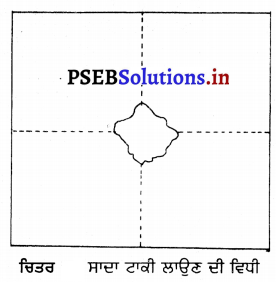
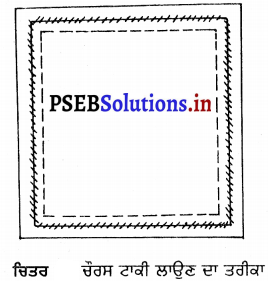
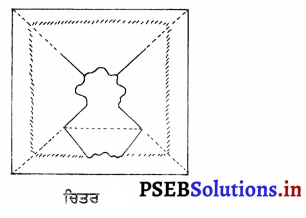
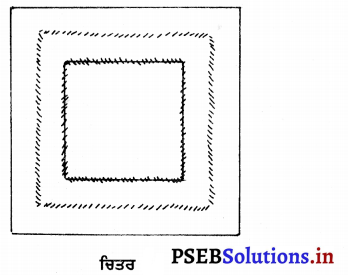
![]()
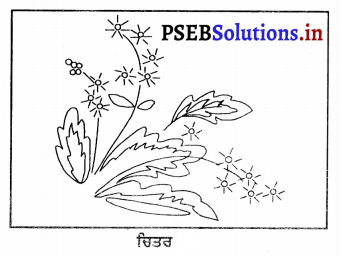
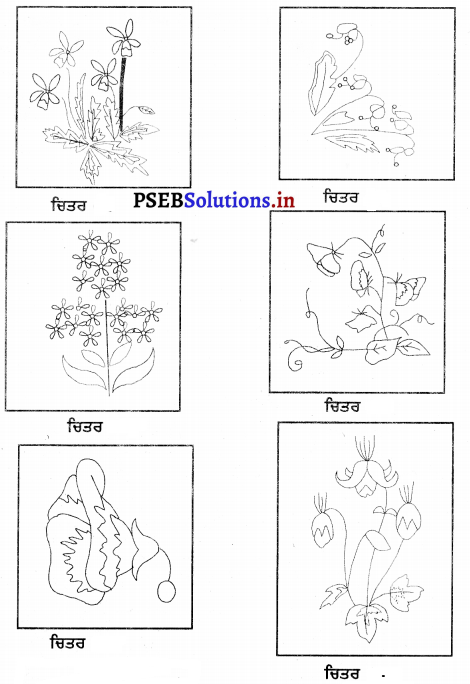
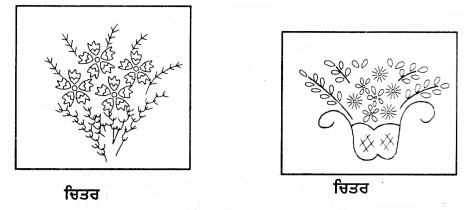
![]()

